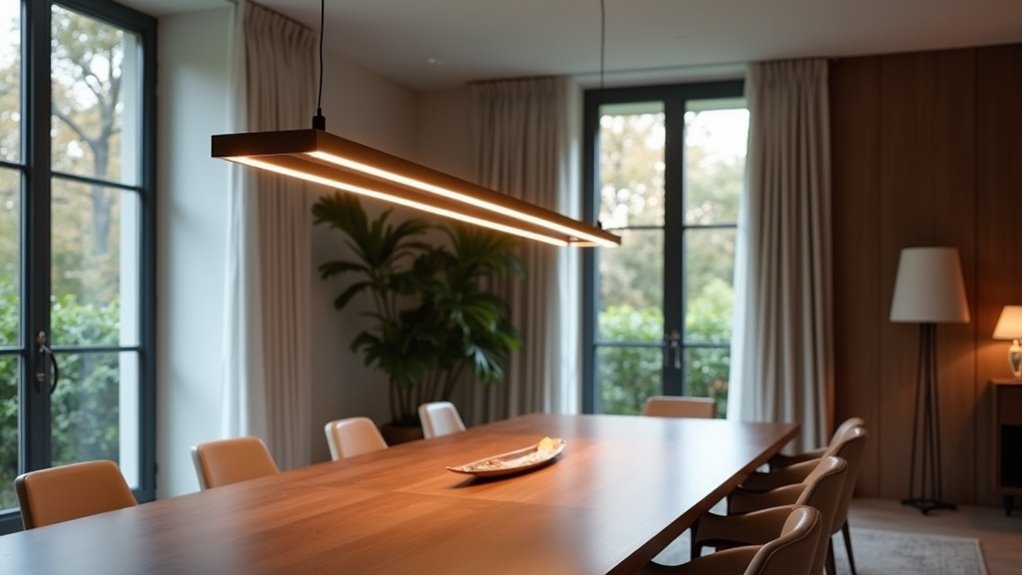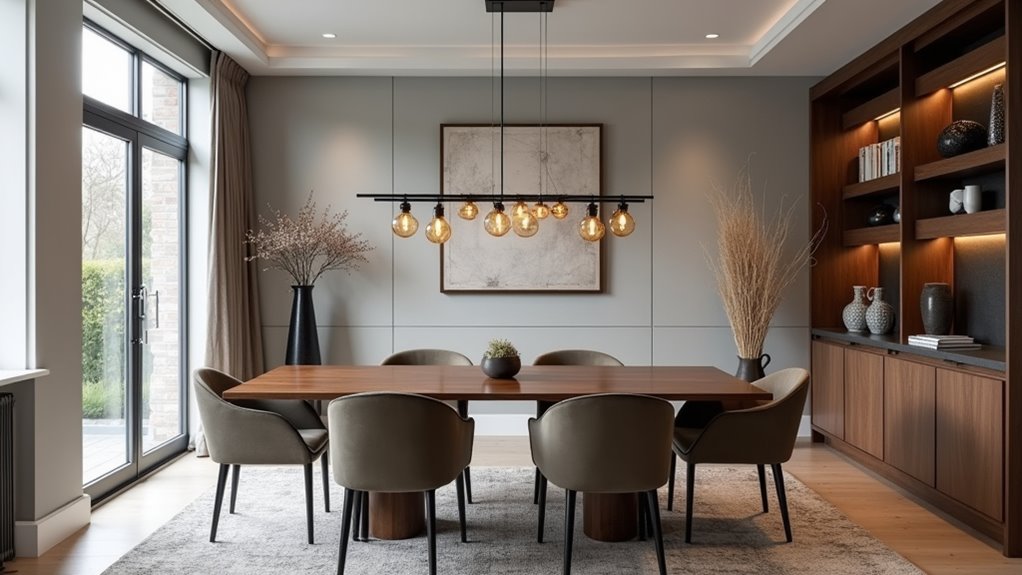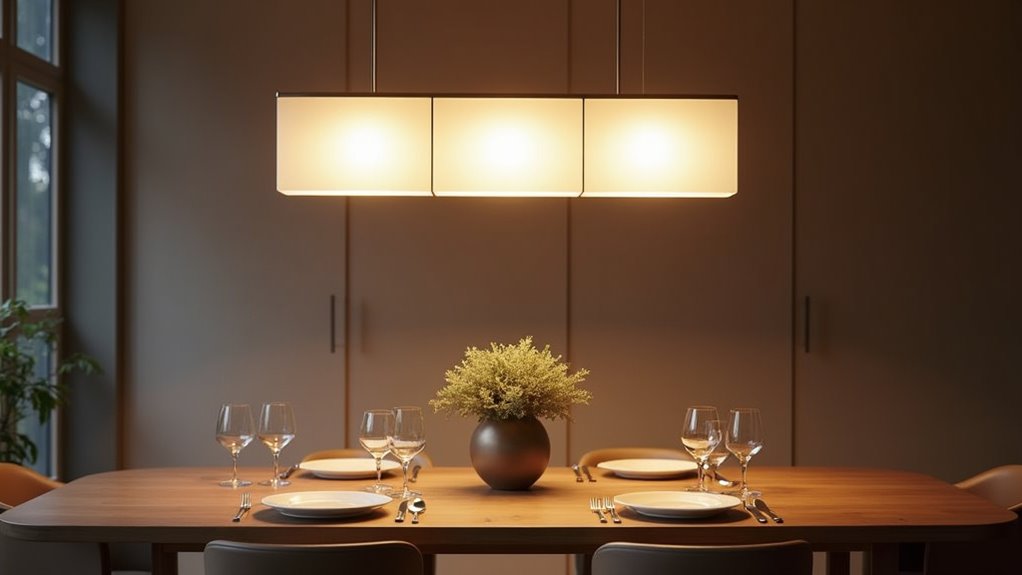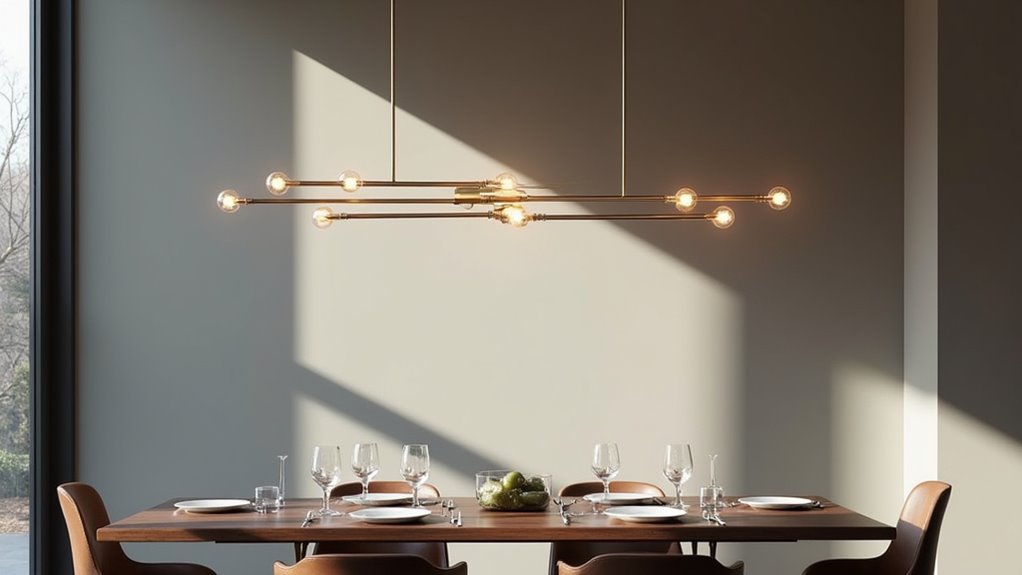Choosing the perfect linear chandelier for a dining table involves key considerations. Ensure the fixture’s length is 1/2 to 2/3 of the table’s length for balanced proportions. Hang it 30-36 inches above the tabletop for an 8-foot ceiling, adjusting for taller spaces. Match the chandelier’s style and finish to the room’s decor, prioritizing modern or transitional aesthetics. Opt for warm, dimmable lighting with high CRI for ambiance. Explore further for deeper insights.
Key Takeaways
- Select a chandelier length that’s 1/2 to 2/3 of your dining table’s length for balanced proportions.
- Hang the fixture 30-36 inches above the tabletop for an 8-foot ceiling, adjusting for taller ceilings.
- Match the chandelier’s style and finish to your dining room’s decor for cohesive aesthetics.
- Ensure brightness of 30-40 lumens per square foot with a warm 2700K-3000K color temperature.
- Choose a fixture with dimming options and high CRI (80+) for optimal light quality.
Sizing Your Linear Chandelier for the Dining Table

When selecting a linear chandelier for a dining table, achieving the right size is crucial for both aesthetic balance and functional illumination. Proportion guidelines suggest the chandelier length should be approximately 1/2 to 2/3 of the table’s length— for a 72-inch table, a fixture spanning 36 to 48 inches works best.
This ensures light coverage and visual harmony without overwhelming the space. Width-wise, aim for 1/4 to 3/4 of the table’s width, or about 1 foot less than the table’s width, to avoid a bulky appearance. Additionally, balanced proportions are essential to ensure adequate lighting coverage across the entire table surface for a cohesive look.
Measurement considerations extend beyond mere dimensions. Room size and the chandelier’s visual weight play key roles—intricate designs may appear larger, while sleek, modern styles can stretch up to 4/5 of the table length. If you encounter issues accessing design resources online, note that some websites may restrict access due to security triggers.
Clients should prioritize balance, ensuring a minimum 6-inch clearance from table ends, aligning personal style with these practical, trend-conscious sizing principles for a polished dining experience.
Determining the Ideal Hanging Height

As the selection of a linear chandelier progresses, determining the ideal hanging height becomes essential for both functionality and aesthetic appeal.
For an 8-foot ceiling, the bottom of the fixture should sit 30-36 inches above the tabletop, ensuring intimacy and measuring clearance for seated guests. With higher ceilings, increase the height by 3 inches per additional foot, adjusting proportions to maintain balance. For instance, a 10-foot ceiling calls for a 36-42 inch range to optimize light spread and visual impact.
To guide clients in achieving the perfect height, consider these key tips:
- Measure from tabletop to fixture bottom for precise clearance.
- Account for ceiling height when adjusting proportions for harmony.
- Test visibility from seated and standing perspectives to avoid obstruction.
- Opt for adjustable fixtures to fine-tune height post-installation.
This ensures a striking focal point without compromising comfort or practicality.
Matching Style and Decor With Your Space

Selecting the ideal hanging height for a linear chandelier sets the stage for a seamless blend of form and function, guiding attention now to the equally important aspect of matching style and decor with the surrounding space.
Homeowners should first assess the dining room’s dominant aesthetic—be it modern, traditional, or industrial—and note furniture lines, textures, and color palettes for Decor Inspiration. Linear chandeliers, with their clean lines, often enhance contemporary or transitional spaces, especially over rectangular tables, ensuring Style Harmony.
Next, consider material and finish coordination. Metals like brushed nickel or matte black should echo room hardware, while wood or glass elements tie into existing textures.
Pay attention to material and finish. Match metals like brushed nickel to hardware, and incorporate wood or glass to reflect room textures.
A bold contrasting finish, such as gold in a neutral space, can create a focal point.
Finally, decide if the fixture blends subtly or stands as functional art, ensuring it complements adjacent areas in open-concept layouts for cohesive design.
Ensuring Proper Brightness and Light Quality

Many homeowners overlook the critical role of proper lighting when choosing a linear chandelier, yet ensuring optimal brightness and light quality can transform a dining space into a welcoming haven.
Brightness levels, measured in lumens, should align with room size—aim for30-40 lumens per square foot. Equally vital is color temperature; a warm2700K-3000K range fosters a cozy ambiance for dining.
To achieve a balanced glow, consider these key tips for light distribution and quality:
- Layer Lighting: Incorporate lighting layers with ambient, task, and accent sources alongside the chandelier to eliminate shadows.
- Check CRI: Opt for a high Color Rendering Index (80+ or90+) to ensure food and decor appear vibrant.
- Explore Dimming Options: Select fixtures with dimming capabilities to adjust mood effortlessly.
- Direct Light: Ensure the chandelier focuses light downward for effective table illumination.
These elements create a dining experience that’s both functional and inviting.



Bài viết cùng chủ đề:
10 Stunning Transitional Chandeliers for Your Dining Room
5 Old Chandeliers for Sale Cheap Available Now
Black Chandeliers Transform Dining Room Ambiance
5 Elegant Crystal Chandeliers That Transform Dining Rooms
5 Stunning Gold Dining Room Light Fixtures for 2025
5 Traditional Chandeliers That Transform Dining Rooms